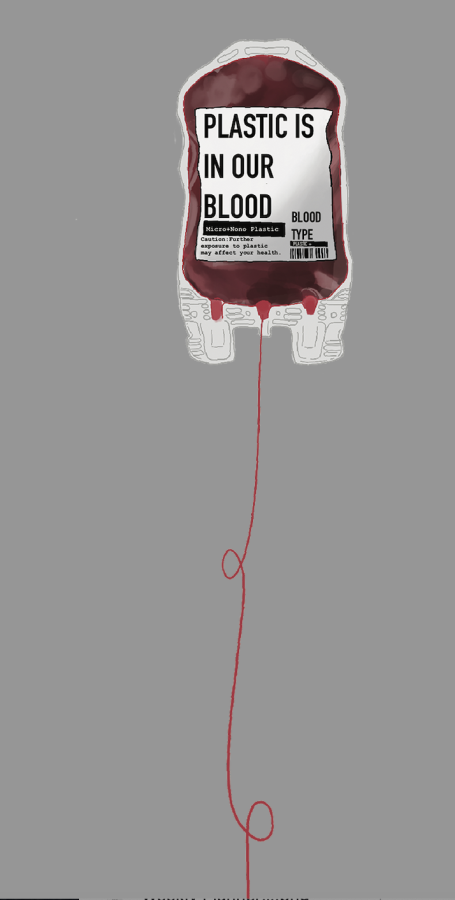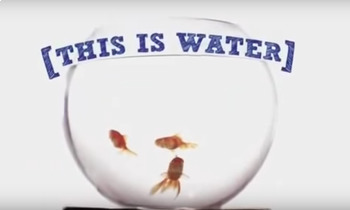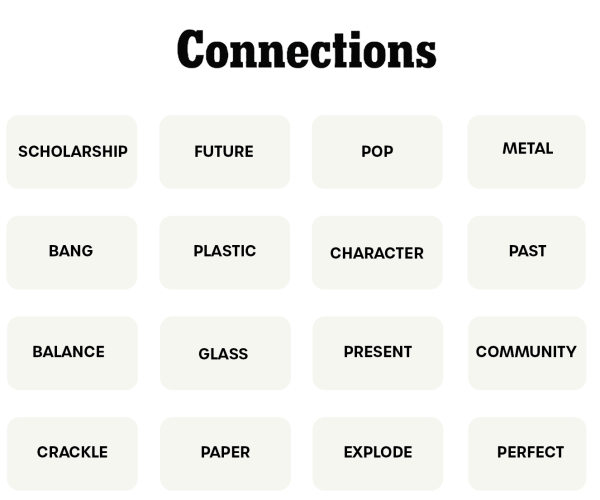Microplastics Found In Human Blood
Humans are ingesting harmful microplastics at an alarming rate, from cosmetics to the food we eat. While the full impact is still unknown, studies show the deteriorating effects on human cells.
June 2, 2022
Remember that Amazon package you opened last Friday or the Starbucks cup you tossed out at lunch? Yeah, those. Did you know that they are full of microplastics? Well, not yet.
While both are made out of plastic, in the end, they will eventually break down into microplastics, full of tiny, microscopic plastic particles that originate from both the breakdown of larger plastics and commercial products.
According to the U.S. National Oceanic and Atmospheric European Chemical Agency, microplastics are tiny fragments of plastic classified as less than 5mm, about the size of a sesame seed, comprising more than 24.4 trillion particles polluting the environment and harming animals and humans in the process.
Microplastics are everywhere and have been a concern for scientists for decades. A reporter from EcoWatch; Linnea Harris in her article: “10 Simple Ways to Avoid Microplastics in Your Everyday Life,” recently said “Scientists warn that if our plastic production and disposal patterns continue, our oceans could contain more plastic than fish as soon as 2050.”
Although, in theory, plastics can be recycled, a hefty amount continues to end up in places like landfills, watercourses, and in marine ecosystems. While they are tiny in size, these plastic particles stay ubiquitous pollutants that permeate every inch of our planet. So why are they harmful?
Derived from petrochemicals extracted from oil and gas products, many of these particles stay toxic due to their carthonegic or mutagenic chemicals, harming cell health and heightening cancer risks. Though many are familiar with the disturbing images of turtles and dolphins stuck in soda rings (yokes) or even fishing nets, underneath, there is a less visible effect found.
A paper recently conducted by Environmental International found plastic in the blood of 17 out of the 22 participants. Following the discovery, a new study developed by researchers found a method for detecting microplastics in human blood, microparticles of four common microplastics were found in the 22 healthy participants conducted in the Netherlands.
Posing as a huge health risk, a study originating from Germany found that microplastic particles can/will destabilize lipid membranes- a barrier that protects all cells- which can ultimately lead to cell malfunction.
Scientists then detected the plastic additives, which included traces of bisphenol A (BPA) and phthalates found in urine, that traced to common polymers.
While many are still invisible to the eye, there are two common microplastics; primary microplastics and secondary microplastics. In comparison, primary microplastics originate from particles in cosmetics (mascara, foundation, etc.), while secondary comes from the breaking down of more oversized plastic items such as plastic bags, soda bottles, and tea bags.
Though much concern continues to surround the effect microplastics have on the marine environments, much of the seafood we consume, like shellfish and fish.
The blood samples collected from the healthy adults were then taken anonymously as they sought to find plastics between 700 and 500,000 nanometers (nm).
To put that into perspective, The Wire Science’s Aathira Perinchery calculated that seven hundred nm to be equivalent to 140 times smaller than the width of a human hair.
Polyethylene terephthalate, or PET, commonly found in disposable water bottles, has now become the most widely encountered plastic polymer after being found in approximately 50 percent of all donors. While the second is polystyrene (PS), which is commonly used for food packaging or foam particles which stay invisible to the eyes.
Just last year, when Amazon’s plastic pollution went under scrutiny, a report released by a non-profit advocacy organization in Oceania said that the e-commerce company was responsible for over 465 million pounds of plastic packaging waste. However, that can’t be the only way plastic may have entered our bloodstreams.
With a variety of food, water, air, and personal care products like toothpaste, lip gloss, and dental polymers, all of them play a huge role in the ingestion of microplastics. In vitro studies recently showed the detrimental effects of microplastics found in cells.
Studies showed the destructive effects of the plastics that could result in cell death leading researchers to believe that “[i]t is scientifically plausible that plastic particles may be transported to organs via the bloodstream,” resulting in particles moving around the body and eventually lodging in organs.
Infamous as it is, plastics also continue to be a major factor in air pollution particles that enter the human body via inhalation, which leads to millions of deaths a year. As vast amounts of plastic waste are heaved into the environment, the contamination of microplastics does not leave an inch of our planet untouched, from the summit of Mount Everest to the Mariana Trench.
Prof Dick Vethaak, an ecotoxicologist at Vrije Universiteit Amsterdam in the Netherlands, says that the short-term exposure the patients had received before the blood samples originated from items such as plastic-lined coffee cups and plastic face masks.
Now “The big question is what is happening in our body?” Vethaak asks, as more in-depth studies show how microplastics latch onto the membranes outside of red blood cells, causing limited ability to transport oxygen.
But not to fear, the good news is also on its way amidst all of these discoveries. Although the decomposition rate of a new piece of polyethylene terephthalate (plastic bottles) can take up to 450 and 1,000 years to become a microplastic, new technology has helped.
Due to non-existing organisms to help break down chemical bonds like plastic, undergoing weather, exposure to waves, wind abrasion, and ultraviolet radiation causes slow degradation. While unfamiliar with the bacteria in nature, now, thanks to a research team from the Institut National de la Recherche Scientifique (INRS) in Canada, they created an electrolytic treatment.
The electrolytic oxidation does not include chemicals but instead helps the water system utilize electricity to induce the removal of contaminants in the water. With the help of water treatment, expert Professor Patrick Drogui believes that this mechanism is an environmentally safe process.
As the plastics get broken down, another process known as initial coagulation and sedimentation helps treat drinking water that faces microplastics. With water being one of the most contaminated things, this advanced treatment can remove 1.8% to 54.4% of microplastic with a larger-than-normal dose of flocculent, which increases the removal to 62%.
However, as technology continues to progress, there are still many implications we can take right now.
Here are some of the top five ways to avoid microplastics in your daily life.
1. Stay away from microwaving your leftovers in plastic Tupperware and instead transfer your food to a ceramic or glass container.
2. Rather than grabbing bottled water due to convenience, turn to a glass or stainless steel bottle.
3. Avoid plastics with the recycling code of 6,7,8 due to the presence of phthalates, styrene, and bisphenols.
4. Look for plastic-free cosmetics and micro-bead-free beauty products, which contain phthalates due to their fragrance.
5. Try replacing tea bags(containing 11.6 billion microplastics) with loose leaves.

















